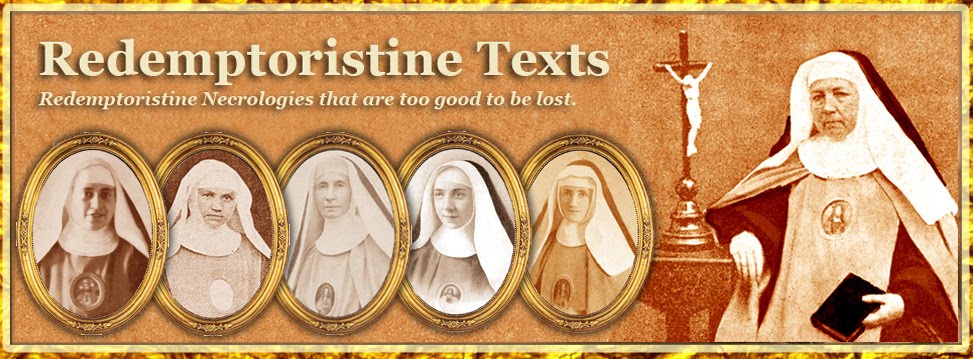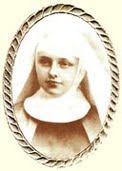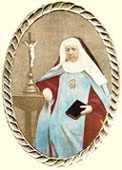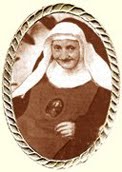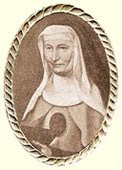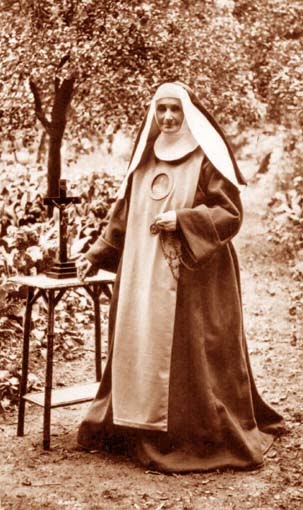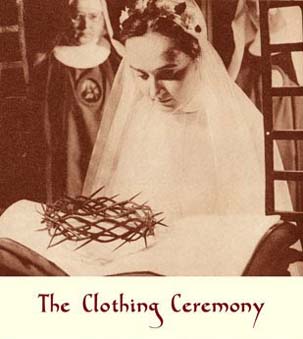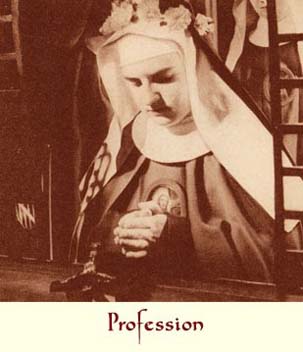* * MONASTERY OF VELP * *
Foundress of the Convent of the Redemptoristines of Velp, near Grave, founded in 1858 [1]
Chapter I. Birth and first years of Marie-Cherubine.
Her vocation to the religious life.
Foundress of the Convent of the Redemptoristines of Velp, near Grave, founded in 1858 [1]
Chapter I. Birth and first years of Marie-Cherubine.
Her vocation to the religious life.
Mother Marie-Cherubine was born on 4th June 1812 at Tirlemont, a town of 8000 souls, situated in Belgian East Brabant, of an honourable and Christian family of the name of Platton. At her baptism she received the name of Celestine. Of the seven children, two boys and five girls, of which the family was composed, she was the third; but it was she who was to become the joy and crown of her parents.
Her mother and father’s great preoccupation was to give their children a perfectly Christian education, and to procure for them an honourable position in society. To this end, they confided Celestine to an instructress of the same town (Miss Angelique) who had a boarding school with twelve girl students. This mistress gave her pupils an excellent education. She taught them not just the different notions that were suited to their condition, but also and above all, the practice of the Christian virtues and religious duties. Her pupils attended all the offices of the Church, and all the processions in the parish, wearing special and modest costumes. They never appeared in public without being veiled.
From her early childhood, Celestine Platton was distinguished among her companions by the meekness and gentleness of her character. She was the glory of her mistress, the consolation of her parents, and served as a model to her brothers and sisters. Her charitable attentiveness made her considered by everyone as a real treasure; and when she was able to spend a few hours in the paternal home, everyone was happy to enjoy the presence of the good and always popular Celestine.
It was thus that she passed her earliest years in acquiring the knowledge which is required to be the ornament of a young lady, and be formed in the practice of all the Christian virtues. After terminating her classes advantageously, she returned to her family, at the age of about eighteen. There she continued her pious exercises and helped her parents in the cares of the household.
Faithful to the good habits contracted in the boarding school, she never appeared in public without being modestly veiled; and, one day when her sister reproached her for it, she replied to her forcefully: “If this inconveniences you, then leave me alone at home.”
Later on, when she felt the desire to leave the world, she approached the holy Table every day.
After she left the boarding school, she often went to see her two older married sisters, and a niece who lived in the countryside near Tirlemont. It was a pleasure for her to render them the most humble services. She was always welcome everywhere. However her family were not to enjoy her presence for much longer.
Already, in the boarding school, God had spoken to her heart, and had suggested her saying farewell to the world and giving herself to Him entirely and undivided. She was then twenty years of age; and always, but now more than ever, the same voice was pressing her to embrace the religious life. This is why, after having prayed much and reflected long upon it, she determined resolutely to finally leave the world and enter a community. But where she should she present herself? There were many communities of women in Tirlemont and the surrounding district; but she felt no attraction for their mode of life. Her choice was thus delayed until a very providential occasion arrived to fix it.
In 1844, two Dutch Redemptorist Fathers, Bernard and Michiels, came to preach a mission at Tirlemont. Their most apostolic words found an echo in hearts. Miss Celestine Platton followed the exercises of the mission ardently. “Oh!” she said to herself, “if only there were also some nuns just as devoted to the salvation of poor sinners, then I would join them straight away!” This wish was to be satisfied sooner than Celestine dared to hope.
Upon Mr. Platton’s invitation, the two missionaries paid him a visit, during which talk turned to Miss Celestine’s wishes. The Fathers made her aware of the Institute of the Redemptoristines which, in its aim, responded perfectly to her views. This Congregation had only recently – in 1841 – been established in Belgium, at Bruges. After some discussion, they came to the conclusion that Miss Platton would go and present herself to the community at Bruges.
But what difficulties did she not have to surmount in order to realise her pious desire! We have now arrived at the year 1844. Celestine, born in 1812, was now thirty two. Can we then be astonished that the Mother Superior of Bruges found her too old to enter their community? However, while refusing her admission, she advised her to go to Vienna (Austria) where she would find another convent of the same Congregation, and she assured her that she would be well received. She even gave her, to this effect, a letter of recommendation.
The young lady was not terrified by the prospect of so long a journey into a foreign country whose language she did not know. However, it was only on 5th October 1845 that she took leave of her dear parents, who only reluctantly and with abundant tears saw their beloved Celestine leave them with scarcely any hope of their seeing her again. Their only consolation was to know that God was asking this sacrifice of them. Their Christian sentiments led them to submit themselves to His holy will.
Celestine Platton thus left and arrived safely at Vienna. She made her entry into religion on 15th October 1845.
Her mother and father’s great preoccupation was to give their children a perfectly Christian education, and to procure for them an honourable position in society. To this end, they confided Celestine to an instructress of the same town (Miss Angelique) who had a boarding school with twelve girl students. This mistress gave her pupils an excellent education. She taught them not just the different notions that were suited to their condition, but also and above all, the practice of the Christian virtues and religious duties. Her pupils attended all the offices of the Church, and all the processions in the parish, wearing special and modest costumes. They never appeared in public without being veiled.
From her early childhood, Celestine Platton was distinguished among her companions by the meekness and gentleness of her character. She was the glory of her mistress, the consolation of her parents, and served as a model to her brothers and sisters. Her charitable attentiveness made her considered by everyone as a real treasure; and when she was able to spend a few hours in the paternal home, everyone was happy to enjoy the presence of the good and always popular Celestine.
It was thus that she passed her earliest years in acquiring the knowledge which is required to be the ornament of a young lady, and be formed in the practice of all the Christian virtues. After terminating her classes advantageously, she returned to her family, at the age of about eighteen. There she continued her pious exercises and helped her parents in the cares of the household.
Faithful to the good habits contracted in the boarding school, she never appeared in public without being modestly veiled; and, one day when her sister reproached her for it, she replied to her forcefully: “If this inconveniences you, then leave me alone at home.”
Later on, when she felt the desire to leave the world, she approached the holy Table every day.
After she left the boarding school, she often went to see her two older married sisters, and a niece who lived in the countryside near Tirlemont. It was a pleasure for her to render them the most humble services. She was always welcome everywhere. However her family were not to enjoy her presence for much longer.
Already, in the boarding school, God had spoken to her heart, and had suggested her saying farewell to the world and giving herself to Him entirely and undivided. She was then twenty years of age; and always, but now more than ever, the same voice was pressing her to embrace the religious life. This is why, after having prayed much and reflected long upon it, she determined resolutely to finally leave the world and enter a community. But where she should she present herself? There were many communities of women in Tirlemont and the surrounding district; but she felt no attraction for their mode of life. Her choice was thus delayed until a very providential occasion arrived to fix it.
In 1844, two Dutch Redemptorist Fathers, Bernard and Michiels, came to preach a mission at Tirlemont. Their most apostolic words found an echo in hearts. Miss Celestine Platton followed the exercises of the mission ardently. “Oh!” she said to herself, “if only there were also some nuns just as devoted to the salvation of poor sinners, then I would join them straight away!” This wish was to be satisfied sooner than Celestine dared to hope.
Upon Mr. Platton’s invitation, the two missionaries paid him a visit, during which talk turned to Miss Celestine’s wishes. The Fathers made her aware of the Institute of the Redemptoristines which, in its aim, responded perfectly to her views. This Congregation had only recently – in 1841 – been established in Belgium, at Bruges. After some discussion, they came to the conclusion that Miss Platton would go and present herself to the community at Bruges.
But what difficulties did she not have to surmount in order to realise her pious desire! We have now arrived at the year 1844. Celestine, born in 1812, was now thirty two. Can we then be astonished that the Mother Superior of Bruges found her too old to enter their community? However, while refusing her admission, she advised her to go to Vienna (Austria) where she would find another convent of the same Congregation, and she assured her that she would be well received. She even gave her, to this effect, a letter of recommendation.
The young lady was not terrified by the prospect of so long a journey into a foreign country whose language she did not know. However, it was only on 5th October 1845 that she took leave of her dear parents, who only reluctantly and with abundant tears saw their beloved Celestine leave them with scarcely any hope of their seeing her again. Their only consolation was to know that God was asking this sacrifice of them. Their Christian sentiments led them to submit themselves to His holy will.
Celestine Platton thus left and arrived safely at Vienna. She made her entry into religion on 15th October 1845.
Footnotes
[1] La vertu cachée. Notice sur la Révérende Mère Marie-Chérubine du Saint Esprit, fondatrice du couvent des Rédemptoristines de Velp près Grave, par le R. P. L. Hagen C.SS.R. (1883) [The hidden virtue. The life of the Reverend Mother Marie-Cherubine, foundress of the convent of the Redemptoristines of Velp, near Grave, by Rev. Fatehr L. Hagen C.SS.R. (1883) – Translated into French from Dutch by Rev. Father Duhamel, C.SS.R.
This necrology is translated from Fleurs de l'Institut des Rédemptoristines by Mr John R. Bradbury. The copyright of this translation is the property of the Redemptoristine Nuns of Maitland, Australia. The integral version of the translated book will be posted here as the necrologies appear.
